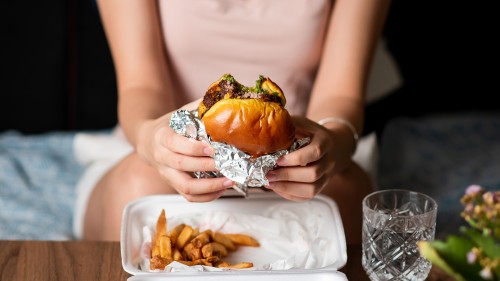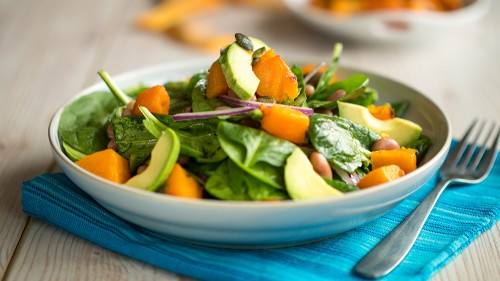What to Know About Processed Foods and Which Ones to Avoid: A Dietitian Explains
Published on January 20, 2022
Medically Reviewed by Ana Reisdorf, MS, RD
When it comes to healthy eating, processed foods have a bad reputation. But where do we draw the line between which foods should be limited and which ones can be part of a healthy lifestyle? Our dietitian explains.


Processed foods have developed a poor reputation in recent decades. But what is considered processed food? And are processed foods really all that bad?
The answer is yes and no. Here’s some information to help you navigate your way through the processed food confusion.
What Are Processed Foods?
The United States Department of Agriculture (USDA) considers any changes of food from its original agricultural state to be a form of processing.
This includes washing, chopping, grinding, cooking, pasteurizing, freezing, dehydrating, and mixing with other food ingredients.
This definition covers most foods we find in today’s grocery stores. There’s a full range of food processing, from minimally processed frozen veggie greens and rolled oats, to ultra-processed meal replacement powders.
Not all of these foods are bad for you just because they are processed. This means that advice to avoid all processed foods is incorrect and that more explanation about the nuance around processed foods is needed.
Understanding how to better categorize healthy and unhealthy processed foods will be explained below. But first, a little history.
Why Are Foods Processed?
Food processing is not new. In fact, it’s something humans have been doing since prehistoric times. (1)
For example, drying meat into jerky and grinding acorns into powder for later use were both primitive forms of processing. As our history advanced, so did our food processing techniques.
Several major factors in our history led to increases in processed food.
To begin with, when humans began farming and pasture-raising food rather than hunting and gathering it, preservation methods such as pickling became necessary so that the foods could be stored for the winter months.
During the industrial revolution in the 19th and 20th centuries, machines were developed, allowing foods to be processed inexpensively and in large amounts.
Storing processed foods became popular, along with using additives to preserve the foods. Over time, thousands of safe and unsafe ingredients have been used to improve palatability and enhance preservation methods.
In the 1860s, Louis Pasteur discovered that microbes caused food poisoning. Pasteurization methods for milk and canned foods became a processing method that increased the safety of the food supply.
Processing sometimes removes healthy components from foods, like the wheat germ and fiber from whole wheat, reducing nutrient density. This type of processing contributes to malnutrition in people who don’t eat a wide variety of foods.
But not all processing is harmful. Another form of processing sparked as scientists began understanding that nutrient deficiencies can cause disease.
Malnutrition within our population led to fortification, or enrichment, standards. Enrichment is when synthetic vitamins and minerals are added to everyday food items like flour, cereal, and salt to solve deficiency problems. (2)
This helped improve the health of the general population.
Summary
Processed foods have been around since prehistoric times. However, the level of processing has increased greatly since the industrial revolution began in the 1800s.
Clearing Up Confusion: The NOVA Classification Groups
Because of the confusion surrounding processed foods, the Food and Agriculture Organization of the United Nations (FAO) now recognizes the NOVA classification system as a good way to categorize foods. (3)
Created in Brazil just a few years ago, the NOVA system puts foods into four defined groups:
| Category | Definition | Examples |
| Group 1: Unprocessed or Minimally Processed Foods | Unprocessed foods as they are taken from nature, or minimally processed foods (such as cut, cooked, chilled, or frozen) that may remove some parts but don’t add sugar, salt, oils, or other ingredients to the original foods. |
|
| Group 2: Processed Culinary Ingredients | Substances extracted from Group 1 foods by industrial processes such as pressing or refining. |
|
| Group 3: Processed Foods | Products made by adding Group 2 ingredients to Group 1 and using preservation methods such as canning or bottling. |
|
| Group 4: Ultra-Processed Foods | Combination of ingredients used to make new food products by industrial means, including the break-down of whole foods, use of added sugar, salt, fat, and chemical additives such as preservatives, artificial sweeteners, thickeners, flavors, or colors, etc. These very palatable foods are made as inexpensively as possible. |
|
As you can see, there are significant differences between the minimally processed foods in Group 1 and the ultra-processed foods (UPF) in Group 4.
The FAO recognizes that when UPFs are consumed more often, essential micronutrients are consumed less and that high consumption of these foods contributes to the global burden of chronic disease. (4)
Steps are now being taken at the United Nations level to work on solutions to help people limit their intake of these foods.
Recommendations include choosing most of your foods from Group 1, limiting foods from Groups 2 and 3, and avoiding Group 4 foods when possible.
Summary
NOVA allows us to better understand the lines between healthy and less-healthy processed foods. For health reasons, it’s best to keep ultra-processed to a minimum in our diets.
Health Risks of Ultra-Processed Foods (UPF)
The way we choose to eat affects overall health.
For decades, research has shown that poor eating habits are a proven risk factor for many lifestyle-related chronic diseases, like diabetes and heart disease. (5)
Overweight and Obesity
Several studies have linked UPF to increases in overweight and obesity trends, which are risk factors for other diseases and mortality.
One study spanning 80 countries from 2002 to 2016 found that with increased sales of UPF, body mass index for people also increased. (6)
In a Brazilian study involving over 55,000 households, consumption of UPF was analyzed with regard to obesity within those homes. (7)
The study found that excess weight increased from 34.1% in the homes with the least amount of UPF consumption to 43.9% in homes that purchased the most.
Cancer
Some studies have found a link between UPF and breast cancer.
One small Brazilian study of 118 women showed that those who ate ultra-processed foods more than five times weekly were at higher risk of breast cancer. (8)
A large study in France showed that a 10% increase of UPF created a 10% increase in overall cancer and breast cancer. (9)
Type 2 Diabetes
Type 2 diabetes (T2D) risk also seems to increase with the consumption of UPF.
A European study involving over 100,000 people showed that higher UPF consumption was consistently associated with T2D risk. (10)
Cardiovascular Disease
Cardiovascular disease is one of the greatest causes of death worldwide.
A large observational study was able to link UPF intake and a higher risk of cardiovascular disease. (11)
The results were still significant when the researchers took other risk factors into consideration, including intake of saturated fats, sugar, and fiber.
Irritable Bowel Syndrome
Many people suffer from irritable bowel syndrome (IBS), a term used by doctors to describe unexplained large intestine problems, including chronic constipation, bloating, and diarrhea.
A large cross-sectional study in France showed that those who ate the highest amount of ultra-processed foods had a higher incidence of IBS. (12)
Dig Deeper: Irritable Bowel Syndrome (IBS): Symptoms, Causes, Treatments, and More
Depression
An estimated 26% of Americans suffer from mental health disorders. (13)
Two extensive studies, one in France and one in Spain, found links between higher intake of ultra-processed foods and depressive symptoms. (14, 15)
Asthma
Children are not exempt from these diet-related risks. A review found children who eat UPF regularly are at higher risk of obesity, type 2 diabetes, and asthma. (16)
A study of over 100,000 9th grade students in Brazil showed that the kids who ate the most ultra-processed foods and drinks were at significantly higher risk for asthma and wheezing than kids who consumed the least. (17)
Summary
Recent studies show that eating high amounts of ultra-processed foods can put people at higher risk for several preventable diseases.
Keep in mind that the concept of NOVA food groups is only a few years old. More studies are needed to determine which foods are the most detrimental to health and why.
List of Processed Foods and Ingredients to Avoid
Consider avoiding or limiting the following foods and ingredients, which are common offenders in the American diet.
Added Sugar
Until recently, added sugar was easily hidden in naturally sweet foods, like dried fruit.
The newest version of the food label distinguishes how much sugar is naturally found in food and how much is added to make it more palatable.
You may be surprised to find added sugar in breakfast cereals, granola bars, jarred sauces, yogurt, instant oatmeal, and salad dressing.
High Sodium
For some people, too much sodium can increase blood pressure, putting them at higher risk for heart attack and stroke.
The American Heart Association recommends eating less than 2,300 mg of salt each day, the equivalent of one teaspoon.
Sodium can be hidden in foods like premade soups, flavored boxed rice and pasta, frozen meals, pickles, canned vegetables and beans, and cheese.
Trans-Fats
Trans-fats are oils that have been processed by bubbling hydrogen through them. This makes the oil solid and more shelf-stable at room temperature.
In other words, using trans-fats or hydrogenated oils is one way to help preserve foods.
Unfortunately, we now know that trans-fats can lead to health problems, including heart disease, so you’ll want to avoid foods that list them on the label.
Because of their known health consequences, many companies have reduced the amount they used to have in their products.
But keep in mind that if a food has less than 0.5 grams of trans-fats, they don’t have to list it in the nutrition facts portion of the label.
Processed Meats
Processed meats like hot dogs, luncheon meats, sausage, bacon, and ham have had a controversial reputation lately.
This is partly because they are usually high in sodium and partly because they are often preserved with nitrates and nitrites. (18)
While these chemicals are naturally found in some healthy foods (like vegetables) and can prevent spoiling by dangerous microorganisms, they have the potential for a carcinogenic or cancer-causing effect when used in meats. (19)
It’s best to limit how much you eat.
Frozen Meals
Just spend a little time reading food labels in the freezer section at your local grocer, and you’ll find that it seems to take a lot of sodium, ultra-processing, and additive ingredients to make the frozen meals and pizzas.
Many companies are working to change this standard, but higher quality, whole-food ingredients are expensive. You can expect to pay more for a healthier frozen product.
Food Additives
There are thousands of food additives that are generally recognized as safe and are approved by the Food and Drug Administration.
These ingredients are commonly used in ultra-processed foods, and are used for preserving, thickening, coloring, scenting, and flavoring.
However, just because it’s been approved as safe doesn’t mean that they add any nutritional value to food.
If you’d like to take a deep dive and decipher exactly what those ingredients are in the processed foods you purchase often, you can find definitions on the FDA’s list of additives. (20)
Summary
There are some common ingredients to look out for on food labels, like added sugar and sodium. Some ultra-processed foods are especially common in the American diet and should be limited for health benefits.
How to Avoid Processed Foods in the Grocery Store
Sometimes it may seem impossible to avoid ultra-processed food. But with a bit of planning, it’s possible to minimize those temptations and keep more healthy foods in your kitchen.
-
Plan weekly trips to the grocery store. This will allow you to buy fresh fruits and vegetables regularly and reduce your need for packaged foods.
-
Double healthy recipes and freeze a batch. It’s a huge time saver and will allow you to skip buying those ultra-processed freezer meals.
-
Consider buying a garage freezer. Having room to store minimally processed frozen foods and your homemade freezer meals can keep your kitchen UPF-free.
-
Never go to the grocery store hungry. Ultra-processed foods are addictively delicious and can be irresistible when you’re hungry. It’s best to go into the store shielded by a full tummy.
-
Make a list and stick to it. A list can help you avoid buying those tempting extras.
-
Learn how to read the nutrition label. A long list of unrecognizable ingredients, added sugar, and sodium is a sign that the food is ultra-processed. (21)
-
Check your canned favorites. Many canned foods that started off healthy, like fruits, vegetables, and beans, are packed in sugary or salty brines that add unwanted calories or sodium.
-
Learn how to store perishable foods to keep them fresh and tasting their best. The USDA has an app that shows you the safest way to store foods and protect your precious purchases. (22)
-
It’s okay to allow for treats. If there’s an ultra-processed food you can’t live happily without, there are usually ways to include them. Of course, moderation is key! Ask your dietitian for ideas on incorporating favorites into your new healthy lifestyle.
Summary
Careful planning before grocery shopping can help you avoid purchasing and eating too many ultra-processed foods.
Frequently Asked Questions
If my children only like to eat ultra-processed foods like chicken nuggets and fish sticks, what should I do?
Many families struggle to find foods that children will eat at mealtimes. However, cooking these favorites from scratch may be easier than you think. For example, countless chicken “nugget” recipes use minimally processed ingredients like chicken breasts and breadcrumbs.
For busy nights when you’re in a pinch, some frozen alternatives are not as processed as others. You’ll want to label-read at the grocery store, looking for whole ingredients like whole grain breading and white meat chicken breasts. Watch out for added ingredients you don’t recognize and shoot for less than 20% of daily recommended sodium.
For people on a budget, what are the least expensive minimally processed foods?
Cooking from scratch is your best and least-expensive bet when it comes to avoiding processed foods. There are many budget-friendly foods in the grocery store that can be simple to cook and tasty to eat.
Here are a few tips: (23)
- Broccoli, cabbage, onions, spinach, carrots, squash, sweet potatoes, apples, and bananas are among the least expensive fruits and vegetables, year-round.
- Buy the more expensive fruits and vegetables when they are in season.
- Frozen fruits and vegetables without added salt and sugar are budget-friendly alternatives to fresh.
- Dried beans, peas, and lentils are inexpensive, healthy proteins.
- Try whole grains like brown rice and oatmeal.
- Buying a whole chicken is generally less expensive than pre-cut.
- Canned fish like salmon can be budget-friendly.
Are meats and poultry considered ultra-processed foods?
Not all meats are ultra-processed. For example, whole, minimally processed meats with no added ingredients like roasts, ground hamburger, whole or cut chicken (with or without the skin), and pork roasts or chops are not ultra-processed. These are generally found in the meat department of your grocery store.
However, foods like lunchmeats, salami, hot dogs, sausages, and chicken nuggets are considered ultra-processed. Research shows that eating these foods often can lead to unwanted diseases.
The Bottom Line
Processed foods are not all the same. Some food-processing techniques have been safely used by humans for thousands of years, and others are detrimental to good health.
The NOVA classification system helps us recognize which ones are healthy (and simply add convenience) and which ones are ultra-processed and should be avoided most of the time.
Eating ultra-processed foods regularly can put adults and children at higher risk for several diseases, including heart disease, type 2 diabetes, gastrointestinal disorders, and even cancer.
With careful planning, there are several ways you can avoid buying ultra-processed foods at the grocery store. However, any food can be part of a healthful diet for most people when eaten in moderation.
Ask your registered dietitian for ways to include your favorite treats, even if they’re processed foods.
At WellnessVerge, we only use reputable sources, including peer-reviewed medical journals and well-respected academic institutions.
- Historical Reflection of Food Processing and the Role of Legumes as Part of a Healthy Balanced Diet:
https://www.ncbi.nlm.nih.gov/pmc/articles/PMC7466326/ - Dietary Reference Intakes: Guiding Principles for Nutrition Labeling and Fortification.:
https://www.ncbi.nlm.nih.gov/books/NBK208880/ - Food and Agriculture Organization of the United Nations: Ultra-processed foods, diet quality, and health using the NOVA classification system:
https://www.fao.org/3/ca5644en/ca5644en.pdf - The Global Burden of Disease:
https://apps.who.int/iris/bitstream/handle/10665/41864/0965546608_eng.pdf - Health effects of dietary risks in 195 countries, 1990-2017: a systematic analysis for the Global Burden of Disease Study 2017:
https://pubmed.ncbi.nlm.nih.gov/30954305/ - Global trends in ultraprocessed food and drink product sales and their association with adult body mass index trajectories:
https://pubmed.ncbi.nlm.nih.gov/31099480/ - Ultra-Processed Food Products and Obesity in Brazilian Households (2008–2009):
https://www.ncbi.nlm.nih.gov/pmc/articles/PMC3965451/ - Nutritional and environmental risk factors for breast cancer:
https://dialnet.unirioja.es/servlet/articulo?codigo=6304361 - Consumption of ultra-processed foods and cancer risk: results from NutriNet-Santé prospective cohort:
https://pubmed.ncbi.nlm.nih.gov/29444771/ - Ultraprocessed Food Consumption and Risk of Type 2 Diabetes Among Participants of the NutriNet-Santé Prospective Cohort:
https://www.ncbi.nlm.nih.gov/pmc/articles/PMC6990737/ - Ultra-processed food intake and risk of cardiovascular disease: prospective cohort study (NutriNet-Santé):
https://www.ncbi.nlm.nih.gov/pmc/articles/PMC6538975/ - Association Between Ultra-Processed Food Consumption and Functional Gastrointestinal Disorders: Results From the French NutriNet-Santé Cohort:
https://pubmed.ncbi.nlm.nih.gov/29904158/ - Mental Health Disorder Statistics:
https://www.hopkinsmedicine.org/health/wellness-and-prevention/mental-health-disorder-statistics - Prospective association between ultra-processed food consumption and incident depressive symptoms in the French NutriNet-Santé cohort:
https://pubmed.ncbi.nlm.nih.gov/30982472/ - Ultra-processed food consumption and the incidence of depression in a Mediterranean cohort: the SUN Project:
https://pubmed.ncbi.nlm.nih.gov/31055621/ - Ultra-Processed Foods and Health Outcomes: A Narrative Review:
https://www.ncbi.nlm.nih.gov/pmc/articles/PMC7399967/ - Associations of ultra-processed food and drink products with asthma and wheezing among Brazilian adolescents:
https://pubmed.ncbi.nlm.nih.gov/29679410/ - Sodium nitrite:
https://pubchem.ncbi.nlm.nih.gov/compound/23668193 - Dietary Nitrates, Nitrites, and Nitrosamines Intake and the Risk of Gastric Cancer: A Meta-Analysis:
https://www.ncbi.nlm.nih.gov/pmc/articles/PMC4690057/ - Food Additive Status List:
https://www.fda.gov/food/food-additives-petitions/food-additive-status-list#additives - How to Understand and Use the Nutrition Facts Label:
https://www.fda.gov/food/new-nutrition-facts-label/how-understand-and-use-nutrition-facts-label - FoodKeeper App:
https://www.foodsafety.gov/keep-food-safe/foodkeeper-app - Seasonal Produce Guide:
https://snaped.fns.usda.gov/seasonal-produce-guide






